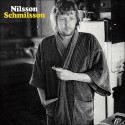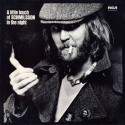Harry Nilsson
| Track | Album |
|---|---|
| 1941 | Pandemonium Shadow Show |
| Remember (Christmas) | Son Of Schmilsson |
| I Guess The Lord Must Be In New York City | Harry |
| The Moonbeam Song | Nilsson Schmilsson |
| Salmon Falls | Duit On Mon Dei |
| Without Her | Pandemonium Shadow Show |
| One | Aerial Ballet |
| All I Think About Is You | Knnillssonn |
| Black Sails | Pussy Cats |
| I'll Never Leave You | Nilsson Schmilsson |
Contributor: Robert Webb
Harry Nilsson is probably best known as the guy who made the top spot early in 1972 with the hairbrush ballad Without You. Or perhaps for singing the Grammy award-winning theme to the 1969 movie Midnight Cowboy, Everybody’s Talkin’.
I’ve always considered Nilsson a great covers artist (viz his take on the Randy Newman songbook) and these two singles surely set the mould as interpretations of Badfinger and Fred Neil respectively (although Tim Buckley’s arrangement of Neil’s Dolphins works just as well for me). Without You and Everybody’s Talkin’ demonstrate Nilsson’s athletic, three-octave vocal range, but they also conceal his equally great talents as a songwriter. So, although I love many of Nilsson’s second-hand songs, I have restricted my Toppermost list here to the singer-songwriter’s originals.
His first few albums – Pandemonium Shadow Show, Aerial Ballet, Harry – feature a clutch of quirky, romantic songs, which often nod at the past, as in the loosely autobiographical 1941, the classically-coloured Without Her (not to be confused with the later Badfinger cover) and One. The first two were composed in a single night, during one of Nilsson’s after-hours sessions as writer for a New York music publisher. He was convinced he would never write another bad song and Without Her duly winged its way into the Billboard charts, thanks to Glen Campbell.
Nilsson’s profile was bolstered in 1968 when John Lennon namechecked him at the press conference for the Apple launch. With the Fabs’ seal of approval, great things were predicted. Everybody’s Talkin’ gave him a first taste of chart success as a performer, and his own submission for Midnight Cowboy, the similar-sounding I Guess The Lord Must Be In New York City, also became a moderate hit in its own right. Gradually, Nilsson was fulfilling expectations.
I first discovered Nilsson with 1971’s uncharacteristically rocky Nilsson Schmilsson. This was the album that spawned Without You, as well as its flop follow-up, the hideously humorous Coconut. By the time I got to it, Nilsson Schmilsson was in the bargain bins and its maker was glugging Brandy Alexanders with John Lennon in LA and recording covers of pre-war songs with an orchestra in London, his career out of time and out of mind with the glam-rock Seventies.
I loved the range of songs on Nilsson Schmilsson – some covers, some original – from its perky opener Gotta Get Up, to another heart-wrencher, I’ll Never Leave You; the languid Moonbeam Song to the upbeat Jump Into The Fire. I was intrigued by its roster of session men, such as Chris Spedding, Bobby Keys and Herbie ‘Walk On The Wild Side’ Flowers. It was a kitchen sink drama, with Harry on the sleeve in his monochrome dressing-gown in front of an open fridge.
Nilsson Schmilsson’s successor was another flippantly-titled album, Son Of Schmilsson (album titles were never his strong point), which contained another nostalgia-tinged ballad, Remember.
In 1973, he triumphantly tackled the Great American Songbook on A Little Touch Of Schmilsson In The Night, one of my favourite Nilsson albums. Harry was always a reluctant performer, but agreed to showcase A Little Touch… in his only full-length concert – albeit in the studio and without an audience – broadcast by the BBC in December 1973. A couple of years earlier he had also starred in his own BBC special, The Music Of Nilsson, on the back of Everybody’s Talkin’. As far as Nilsson live goes, that’s about it.
The standards album was seen as a bold move, although Nilsson did declare on a later song (I’ll Take A Tango), “Deep down in my soul I hate rock and roll”. So it was with some irony that he teamed up with Lennon the following year for Pussy Cats, an album born in the doldrums of Lennon’s own faltering “oldies” collection, Rock ‘n’ Roll, and a respite from the pair’s Hollywood Vampire lifestyle. Mostly consisting of covers, Pussy Cats did feature two great originals in Black Sails and Don’t Forget Me. Nilsson’s propensity for the sad song, fuelled now by pills and booze, was never more morbid. As the sessions drew to a close, on 28th March 1974, Paul McCartney dropped by and in a druggy jam with Nilsson, the ex-Beatles cut the last tracks they would make together. The shambolic, if historic, results were sensibly confined to bootleg.
But with the achievements came a run of unexpected turns, rash moves and plain old bad luck, all of which conspired to keep Nilsson’s profile lower than he deserved. A Ringo Starr-backed movie, Son Of Dracula, failed to bite, as did a later musical, Zapata, which managed just one performance. Nilsson ruptured his vocal chords during the recording of Pussy Cats and never made a truly great album again, although in 1975 he released one of my favourites, Duit On Mon Dei (as in “do it on Monday”), with majestic steel-band arrangements by another maverick musical hero, Van Dyke Parks. It includes Salmon Falls, Puget Sound and Down By the Sea – all worth exploring.
Another awkwardly-titled album, Knnillssonn, appeared a month before label-mate Elvis Presley’s death in 1977 and promotion suffered as a result. Nevertheless, it contains some solid material, delivered with the help of Klaus Voorman and the St. Paul’s Cathedral Choir. All I Think About Is You is the last of the great Nilsson songs.
Like Elvis, I suppose, Nilsson’s career terminally faltered thereafter. In 1978, the year he started recording his final album – the disappointing Flash Harry (not even released in the US, when it finally appeared in 1980) – the Who’s drummer Keith Moon was found dead in Nilsson’s London flat. This was the same apartment in which Mama Cass Elliott had suffered heart failure in her sleep four years earlier, at the same age. Rock’s most unlucky address.
Increasingly, Nilsson walked on the dark side, it seemed. After Lennon’s murder in 1980, he diverted his energies into the Coalition to Stop Gun Violence and dropped into a tailspin of diabetes and depression through the Eighties, exacerbated by the revelation that his earnings had been embezzled by a financial advisor. He returned to the studio to record material for an unreleased album in the Nineties but it remains on the shelf even following Nilsson’s death in 1994.
Harry Nilsson (1941-1994) – official website
Harry Nilsson: A Little Touch of Schmilsson on the Net
Who is Harry Nilsson? (And Why Is Everybody Talkin’ About Him)
Nilsson: The Life of a Singer-Songwriter by Alyn Shipton
The Harry Nilsson Archive on YouTube
“The Music of Nilsson” – BBC complete programme (1971)
Harry Nilsson on “Playboy After Dark” (1968)
Papa’s Got a Brown New Robe – full album (1993) – unreleased
Nilsson biography (Apple Music)
Robert Webb is a freelance writer and editor. His writing has appeared in The Independent and BBC Online. He is the author of
The 100 Greatest Cover Versions and a book on John Lennon.
TopperPost #483












Great list, One, Without Her and I Guess are all favourites of mine. Harry is one of those artists who is forever lurking around in the back of your mind, you don’t spend a whole lot of time thinking about him (or talking about him…sorry) but when you hear his songs he’s a reference point to important times in your life. I first came across him in early primary school through that strange and wonderful tele film The Point and the song Me and My Arrow. I hummed it for years without ever knowing it was Harry. A great songwriter we now view him as a great singer and interpreter of other people’s work, A Little Touch of Schmilsson is the first of the now ubiquitous songbook albums, he beats Stardust by five years. I know Without You is now part of the wallpaper of life but I had an Ipod moment the other day when Badfinger’s original version popped up in the middle of a long playlist. Listening to it brought me back to having another proper listen to Harry’s version, what a performance. It is easily a candidate for the last song to be played when the world comes to an end.